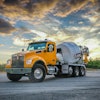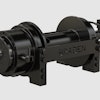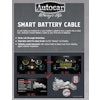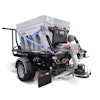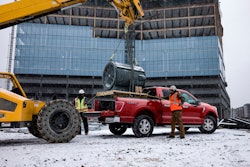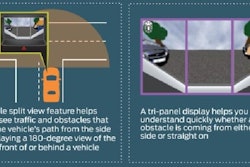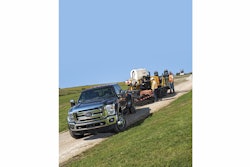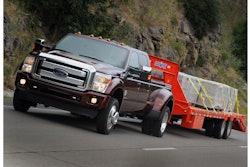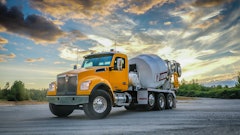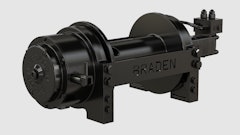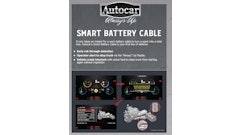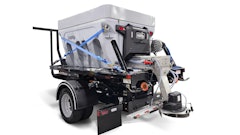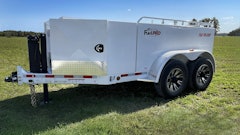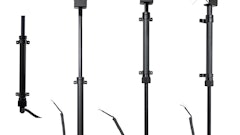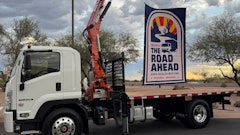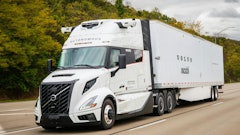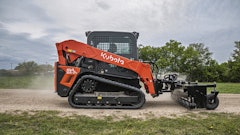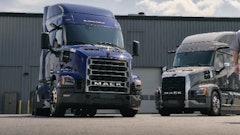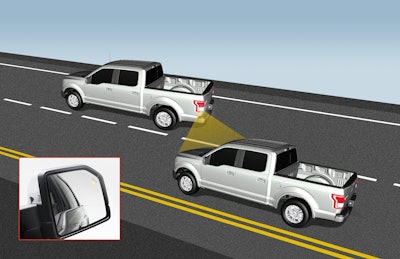
Considerations driving many construction pickup truck purchase decisions can focus on fuel efficiency, life-cycle costs, greater payload and towing capability. But the recent proliferation of effective safety features should elevate safety to equal status with performance and cost effectiveness at pickup buying time. Some manufacturers offer exclusive features not matched by the other nameplates.
Unlike previous generations where safety features often lagged behind their automotive counterparts, today’s pickups feature safety technology that didn’t even exist a few years ago. We have progressed from simple seatbelts and driver’s side airbags to computers that constantly monitor objects around the pickup and work to keep the vehicle under control by regulating engine power and braking. Much of this technology — such as electronic stability control, trailer tow control and traction control — is a direct result of electric systems integration between components. Other systems, such as lane departure warning, backup cameras and automatic windshield wipers, have migrated from the automotive market.
This safety revolution seems to have been largely overlooked as customers have been awed by the dramatic increases in towing and payload capability over the last few years. If your pickups are even four or five years old, you may not be aware of the most recent advancements. More advanced seatbelt systems and multiple airbags manage energy when a collision occurs and protect the drivers and passengers from every angle.
In terms of airbag advancements, many trucks now offer side curtain airbags. Mounted along the interior roof line above the door, these bags drop down to protect your head in the event of a side impact or rollover.
New airbag technologies continue to evolve. For instance, Ford offers a second row inflatable safety belt that works like a traditional belt, but it includes a tubular airbag that inflates in the event of a crash and distributes the force of impact across a wider area of the passenger’s chest.
Seatbelt technology also continues to evolve. Instead of static belts anchored to the body of the vehicle, seatbelts now include pre-tensioners that tighten to remove slack when an accident occurs, reducing that initial harsh impact of body-against-belt. Some manufacturers have stepped up the game by installing pre-tensioners that ease off as the impact progresses, absorbing force that would normally be transferred from belt-to-body.
Keep Control
Avoiding accidents often comes down to maintaining control.
Pickups have more mass than a typical automobile, which gives operators a feeling of security in the advent of a collision. But the downside is they also have a higher center of gravity, which can lead to roll stability issues. To address these issues and provide an additional measure of control, the major manufacturers all offer sophisticated electronic stability control systems that use software in conjunction with anti-lock brake systems and the engine to provide the necessary inputs to keep your pickup safely on the intended path. These systems use algorithms that factor in g-forces, vehicle speed and other parameters to immediately provide corrective responses.
Ram Truck's Electronic Stability Control serves as a good example. It includes Hill Start Assist, Trailer Sway Control, Rain Brake Support, Brake Assist and Ready Alert Braking. These features help maintain directional stability under all conditions, but prove particularly beneficial when traveling on snow, ice or gravel.
The StabiliTrak electronic stability control system is standard on all GMC Sierra and Chevrolet Silverado 1500 models. It works in concert with the four-wheel disc brake system and four-channel ABS to provide more precise and controlled ABS stops, greater traction and improved cornering stability. It also incorporates rollover mitigation technology, which anticipates tip-up conditions (such as fishtailing) on a flat road surface and rapidly applies brake pressure to help reduce the likelihood of a rollover.
GM pickups also offer hill descent control, which is engaged by the driver and uses the anti-lock braking system to enable a smooth and controlled descent in rough terrain. It is standard with the Z71 off-road package-equipped All Terrain and available on other models.
In addition, an automatic locking differential option on Chevrolet Silverado and GMC Sierra pickup trucks reacts in milliseconds in low traction situations without any driver input. The rear axle engages when a wheel speed difference of 100 rpm or more is detected between the left and right wheels, providing instant traction.
Keeping the increased mass of a pickup truck under control is a primary concern. Ford’s Curve Control automatically provides more aggressive four-wheel braking when the truck is going into a corner too fast. Stability control automatically senses when the vehicle’s handling limits have been exceeded and reduces engine power and/or applies the brakes to help the driver maintain control.
Likewise, Ram Truck's all-speed traction control senses drive wheel slip and applies individual brakes to slipping wheels and reduces excess engine power until traction is regained. A brake lock differential system (BLDS) allows the vehicle to maintain forward motion if one or two wheels lose traction by selectively and aggressively applying brakes to the spinning wheels.
Some systems even adapt to changing weather conditions. Rain brake support on Ram Truck uses the system’s electronic stability control (ESC) pump to occasionally push brake pads lightly against brake rotors in rainy conditions in order to keep rotors dry and ensure maximum braking performance under wet conditions.
Be Aware of Surroundings
The ability to detect and avoid objects in the pickup truck’s intended path is a relatively new development, but is quickly being adapted as an option on many of the current offerings.
Select GMC Sierra and Chevrolet Silverado pickups are available with a Driver Alert Package. This includes a lane departure warning, forward collision alert and safety alert seat. Forward collision alert technology indicates when the truck is closing in on a vehicle too quickly, providing additional time to react and avoid a crash. It tracks the vehicle ahead using a forward-facing camera and a three-step visual and sound alert, while the safety seat alert uses directional vibrations to warn of crash threats. Lane departure warning technology alerts the driver when the truck drifts over a lane line traveling at least 35 mph. In addition, a rear-vision camera is standard on Chevrolet and GMC pickups with SLE, SLT and Denali trim levels.
But camera technology is evolving beyond backup cameras. Ford offers a 360° camera view on select models that uses exterior cameras to create a bird’s eye view of the truck to help the driver park, maneuver in tight spots and navigate down narrow trails. In addition, there is an available trailer hitch assist camera that adds a dynamic line in the display based on steering wheel angle to help customers line up the truck and trailer without requiring a spotter or having to get out of the vehicle.
Radar technology further ratchets up the driver’s ability to identify surrounding hazards. Ford offers a Blind Spot Information System with cross-traffic alert. It uses radar hidden in the tail lamps to detect a vehicle entering a driver’s blind spot while driving slowly or backing up.
Radar can also help prevent frontal collisions. For instance, Ford’s adaptive cruise control allows drivers to set a cruising speed and then uses radar technology to monitor traffic ahead and maintain a set distance between vehicles. A lane-keeping system is designed to help avert unintentional drifting of the vehicle outside the intended lane by automatically detecting the left- or right-hand road lane markings using a camera mounted between the windshield and interior rearview mirror.
Ram Truck aids visibility with the ParkView rear backup camera and ParkSense front and rear park assist system. The ParkView camera, hidden in the tailgate handle, helps take the guesswork out of parking or backing up to a trailer. It provides a wide-angle view of the area immediately behind the vehicle, along with guidelines that take steering input into consideration. At low forward speeds, ParkSense detects stationary objects with audible warnings for the driver. The ParkSense rear park assist detects stationary objects in low speeds in reverse and provides audible warning for the driver, plus has a display on the multi-view screen.
Ram Truck also aids other drivers’ visibility with SmartBeam headlamps that sense oncoming traffic during night driving conditions, and automatically switch from high- to low-beam and back again when the traffic has passed.
Safely Tow Lloads
With the increased payload capacity available on most full-size and heavy-duty pickups, keeping heavy loads under control deserves close attention. Trailer sway control is one technology to improve adverse handling caused by crosswinds and traffic.
Trailer Sway Control is standard on Chevrolet and GMC pickup trucks and works with StabiliTrak to provide an added measure of confidence when towing a trailer. It senses the condition of trailer sway and, without input from the driver, intervenes with braking and/or reduced engine power to bring the trailer under control and keep it on its intended path. The system will use electric trailer brakes when a trailer is plugged into the standard wiring harness.
The Ford Super Duty comes with a number of features that make towing safer. These include roll stability control, trailer sway control, an electronic locking rear differential, integrated trailer brake controller and electronic stability control. They help control trailer sway and help you maintain control of the load at all times. In addition, an available smart trailer tow module helps identify and inform the driver of potential trailer connectivity issues, burned or unlit trailer marker lamps and brake light and trailer battery faults. An integrated trailer brake controller allows you to automatically or manually activate the electronic brakes on properly equipped trailers for greater stopping power on downhill grades.
Getting heavy loads started on steep hills can also raise the hair on the back of your neck. Ram Truck offers Hill Start Assist, which helps drivers by maintaining the level of brake pressure applied for a short period of time after a driver’s foot is removed from the brake pedal. If the throttle is applied within a short period of time after a driver’s foot is removed from the brake pedal, brake pressure will be released.
The safety features mentioned are by no means a comprehensive list, and new safety technologies continue to evolve. Make sure you check with your local dealer to find out what features are available and which options make the most sense for your applications.
